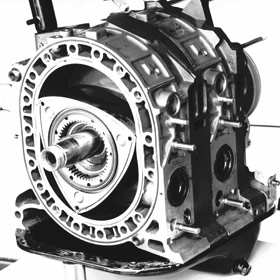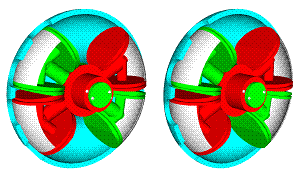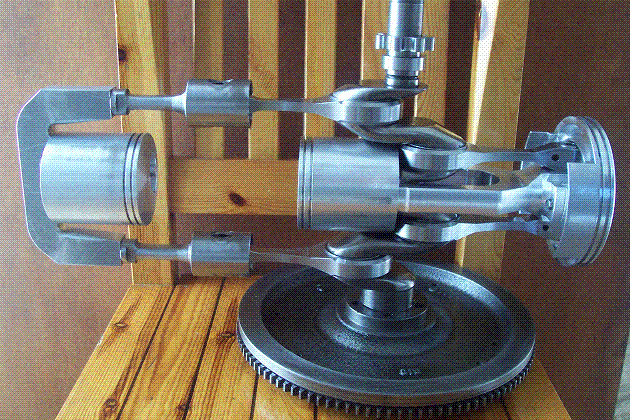Anyone know about any interesting articles to share about camless engines?
Here is one link. http://autospeed.com/cms/title_Camless-Eng...10/article.html
Having infinitely variable cam timing would open so much performance and economy it just boggles my little mind!
And not having cam chains to worry about would be something positive also. Just imagine a 2 liter type 4 with heads that would essentially have dual overhead camshafts with infinitely variable valve timing. WOW!!
Tom
Full Version: Camless engines
I have a friend that worked as an instructor at an advanced BMW tech training center. I was at the school and he showed me some BMW heads that had solinoids or something that were running the valves. Very cool. No loss of HP turning cams, no verio parts to fail.
From the article (which is dated)
International Truck and Engine Corp is another engine manufacturer poised to take a huge step forward in diesel engine design, announcing that it will eliminate camshafts from its diesel engines and replace them with electronic-valve timing systems by the year 2007
Did this happen?
Rich
QUOTE
International Truck and Engine Corp is another engine manufacturer poised to take a huge step forward in diesel engine design, announcing that it will eliminate camshafts from its diesel engines and replace them with electronic-valve timing systems by the year 2007
Did this happen?
Rich
begs to question.
Do valves need to be round?
A square port slide mechanism may be more durable and easier to build...
How about a triangle?
Rich
Do valves need to be round?
A square port slide mechanism may be more durable and easier to build...
How about a triangle?
Rich
begs to question.
Do valves need to be round?
A square port slide mechanism may be more durable and easier to build...
How about a triangle?
Rich
For that matter, do they need to be shaped like valves at all? If electromechanically operated, couldn't it be something akin to a hinged "trap door" design?
QUOTE
For that matter, do they need to be shaped like valves at all? If electromechanically operated, couldn't it be something akin to a hinged "trap door" design?
like reed valves for a snowmobile or motorcycle engine?
Round are easiest to seal as well.
I'm not sure why they would need to rotate; it is a different application, but many high quality industrial valves are non-rotating to keep from scratching the seats (and hence ruining the sealing surface).
I'm not sure why they would need to rotate; it is a different application, but many high quality industrial valves are non-rotating to keep from scratching the seats (and hence ruining the sealing surface).
They rotate to seat better. When we switch valves in a head ina car we spin them on purpose with valve lapping compound to assure that the seat shape and the valve shape are identical and provide a really good seal. Round is easier to assure the seal because of the ability to spin them in this procedure.
Look closely at the alignment between a rocker and the valve stem. Where the adjuster contacts the valve is slightly off center to rotate the valve a little bit each time it is moved.
Look closely at the alignment between a rocker and the valve stem. Where the adjuster contacts the valve is slightly off center to rotate the valve a little bit each time it is moved.
Round is necessary. Points would focus heat and break down from heating up. Think how you have to smooth the combustion chamber to guard against hot spots.
Rotary cam is nothing new. (google it)
Compact nuclear... Now that's where it's at.
Seriously though, rotary makes sense. Even if as primitive as centrifugal timing variation, it's all rolling with the flow.
On the contrary, solenoid-driven, or anything else that relies on stop and go motion is way more complex and inefficient and prone to quick wear (and thus more frequent adjustments to stay within spec).
Compact nuclear... Now that's where it's at.
Seriously though, rotary makes sense. Even if as primitive as centrifugal timing variation, it's all rolling with the flow.
On the contrary, solenoid-driven, or anything else that relies on stop and go motion is way more complex and inefficient and prone to quick wear (and thus more frequent adjustments to stay within spec).
They rotate to seat better. When we switch valves in a head ina car we spin them on purpose with valve lapping compound to assure that the seat shape and the valve shape are identical and provide a really good seal. Round is easier to assure the seal because of the ability to spin them in this procedure.
I understand that lapping is used to match the valve/port together in order to promote good sealing. You do this whenever you assemble an industrial valve or, like you said, head.
The part I don't understand is the necessity of valve rotation while the motor is running. At that point there is no guarantee of even surfacing, and any crap that gets on the seat can randomly scratch it, messing up the sealing surface.
QUOTE
The part I don't understand is the necessity of valve rotation while the motor is running. At that point there is no guarantee of even surfacing, and any crap that gets on the seat can randomly scratch it, messing up the sealing surface.
You might be surprised how much valves rotate. Just by nature, it happens. I've seen some great videos... Maybe a link to one will show up soon.
http://www.pattakon.com/pattakonDesmo.htm
Maybe not camless but it's definitely a new way to use a cam. This site has some really cool designs and some cool animations to show the function,
I'm not sure where I stumbled across this site but I spent like 2 hours reading all the pages
Maybe not camless but it's definitely a new way to use a cam. This site has some really cool designs and some cool animations to show the function,
I'm not sure where I stumbled across this site but I spent like 2 hours reading all the pages
Whoah!
Thas some cool chit.
I wonder if any of these ideas wil reach production.
Thas some cool chit.
I wonder if any of these ideas wil reach production.
..........most all TWO cycle engines....(as we call them)....have no valves...as we Normally think of valves....and no camshaft....In past years their have been very few engine designers who have attempted to utilize this simple method applied to cars....In the diesel truck engine world their are "two" cycle engines....Their must be some reason this simple system has not been refined /developed for cars, but I certanily miss the point....Diesels turning 1200 rpm, or motorcycle engines turning 12000 rpm, surely their is some one smart enough to design a variable RPM /torque/HP , two cycle engine.
Obvious?

This is what I thought of when I saw the title. I don't have much else to add.

This is what I thought of when I saw the title. I don't have much else to add.
Two cycle is just that. Twice as many power pulses as 4 cycle. As in 12 cylinders 4 cycle compared to 6 cylinders 4 cycle. Most 2 cycle motors are tuned with an exact exhaust system for the utmost power. The ones I am familiar with are not fuel efficient. My 350cc 2 cycle 69 kawasaki twin made 42 hp. It used a rotary disk on the crank with a notch in it letting the intake port open before the piston started up. Wider notch = more duration and more power at high rpm. Expansion chamber exhaust to tune the power band. When a rotary valve would come loose on it's splined sleeve on the crank the motor would have one cylinder that would only make power at one rpm and it would vary with how much the valve would free spin.
You want camless?
Check out the Kugelmotor! Kind of like rotory does 3D.
http://www.youtube.com/watch?v=0CmGJucRDBk
Check out the Kugelmotor! Kind of like rotory does 3D.
http://www.youtube.com/watch?v=0CmGJucRDBk
You want camless?
Check out the Kugelmotor! Kind of like rotory does 3D.
http://www.youtube.com/watch?v=0CmGJucRDBk
Here is another "rotary" engine (shown stereoscopically)

presented at http://www.pattakon.com/pattakonRotary.htm
and here is another cam-less engine (two stroke direct injection Diesel):

presented in details at http://www.pattakon.com/pattakonPatOP.htm
Here is the Youtube video of the engine running on Diesel fuel standing free on a desk: http://www.youtube.com/watch?v=2ByEgfTTq1I
Thanks
Manousos Pattakos
Manousos, 
Thanks for joining and posting. You have some very interesting designs
Thanks for joining and posting. You have some very interesting designs
I love the simplicity of these VVT and alternate combustion ideas
The stereo views are cool, but my simple brain won't let me "see" it right yet.
Manousos, are you sponsored for this research and development, or just gifted and compelled to make things?
The stereo views are cool, but my simple brain won't let me "see" it right yet.
Manousos, are you sponsored for this research and development, or just gifted and compelled to make things?
I love the simplicity of these VVT and alternate combustion ideas
. . .
"The stereo views are cool, but my simple brain won't let me "see" it right yet."
Quote from http://www.pattakon.com/pattakonStereoscopy.htm :
To see stereoscopically, just hide the left image from your left eye and the right image from your right eye by your palms and then try to concentrate your sight on a small object located at the intersection of the line from your left eye to the right figure and the line from your right eye to the left image. The "software" is already into the brain waiting for activation. The result is stunning.
"Manousos, are you sponsored for this research and development?"
No.
Thanks
Manousos Pattakos
This is a "lo-fi" version of our main content. To view the full version with more information, formatting and images, please click here.
